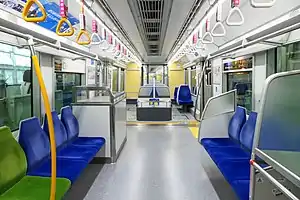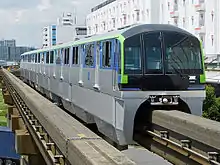| Tokyo Monorail 10000 series | |
|---|---|
 Set 10081 in May 2021 | |
 | |
| In service | July 18, 2014 – Present |
| Manufacturer | Hitachi Rail[1] |
| Built at | Yamaguchi |
| Family name | Hitachi Monorail |
| Replaced | 1000 series |
| Constructed | 2014– |
| Number built | 48 vehicles (8 sets) |
| Number in service | 48 vehicles (8 sets) |
| Formation | 6 cars per trainset |
| Fleet numbers | 10011–10081 |
| Operators | Tokyo Monorail |
| Depots | Showajima |
| Lines served | Tokyo Monorail Haneda Airport Line |
| Specifications | |
| Car body construction | Aluminium alloy |
| Car length | 16.4 m (53 ft 10 in) (Tc) 15.2 m (49 ft 10 in) (M) |
| Width | 3,038 mm (9 ft 11.6 in) |
| Height | 4,364 mm (14 ft 3.8 in) |
| Doors | 2 pairs per side |
| Maximum speed | 80 km/h (50 mph) |
| Traction system | Hitachi 2-level IGBT–VVVF inverter vector control |
| Traction motors | 16 × 100 kW (134 hp) 3-phase AC induction motor |
| Power output | 1.6 MW (2,146 hp) |
| Acceleration | 0.97 m/s2 (2.2 mph/s) |
| Deceleration | 1.1 m/s2 (2.5 mph/s) (service) 1.3 m/s2 (2.9 mph/s) (emergency) |
| Electric system(s) | 750 V DC |
| Current collector(s) | Side contact |
| Safety system(s) | ATC |
| Track gauge | (straddle-beam monorail) |
The Tokyo Monorail 10000 series (東京モノレール10000形, Tōkyō Monorēru 10000-gata) is a monorail electric multiple unit (EMU) train type operated by the Tokyo Monorail on the Tokyo Monorail Haneda Airport Line in Japan since July 2014.[2]
Design
The body design is based on the earlier 2000 series trains first built in 1997, and uses friction stir welded (FSW) aluminium alloy panels.[3]
 The interior of the driving cab
The interior of the driving cab
Formation
As of 1 April 2023, the fleet consists of eight six-car sets, numbered 10011 to 10081, and formed as shown below, with four motored ("M") cars and two non-powered trailer ("T") cars.[2] Car 1 is at the Hamamatsucho end.[2][4]
| Car No. | 1 | 2 | 3 | 4 | 5 | 6 |
|---|---|---|---|---|---|---|
| Designation | Tc1 | M1 | M2 | M3 | M4 | Tc2 |
| Numbering | 100x1 | 100x2 | 100x3 | 100x4 | 100x5 | 100x6 |
| Weight (t) | 23.3 | 23.7 | 24.1 | 23.8 | 24.0 | 23.0 |
| Capacity (seated/total) | 33/76 | 40/76 | 33/76 | |||
- "x" stands for the set number.
- Cars 1 and 6 each have a wheelchair space.[4]
Interior
Passenger accommodation consists of a mixture of facing 4-seat bays and longitudinal bench seating, and includes luggage racks next to the doorways.[3] The seats are covered in a blue moquette incorporating the traditional Japanese seigaiha (青海波) pattern.[3] LED lighting is used throughout.[3] Passenger information is provided by 7-inch wide LCD displays above the doorways.[3] Information is provided in four languages: Japanese, English, Chinese, and Korean. Initially one screen is provided above each doorway, but provision is made for installing a second screen in the future.[3]
 Longitudinal seating
Longitudinal seating Facing 4-seat bays
Facing 4-seat bays Seating over the train bogies
Seating over the train bogies
History
The first set, 10011, was delivered to Tokyo Monorail's Showajima Depot in March 2014.[5] It entered revenue service on 18 July 2014.[6]
 The first set delivered, 10011, at Showajima Depot in March 2014
The first set delivered, 10011, at Showajima Depot in March 2014
Structural damage
On 31 May 2022, structural cracks were discovered on seven 10000 series trainsets, causing a reduction in peak-hour service from every four minutes to every five minutes.[7] The cracks were mainly found on an aluminum part which connects the body of the vehicle to the bogie.
References
- ↑ "Development of 10000 Series Rolling Stock for Tokyo Monorail" (PDF). Hitachi Review. No. 10 (Vol. 63). 2014. Retrieved 8 January 2019.
- 1 2 3 "東京モノレール10000形" [Tokyo Monorail 10000 series]. Japan Railfan Magazine. Vol. 54, no. 638. Japan: Koyusha Co., Ltd. June 2014. pp. 80–81.
- 1 2 3 4 5 6 Harada, Junichi (April 2014). 新型車両10000形の導入について [Introduction of new 10000 series rolling stock]. Tetsudō Daiya Jōhō Magazine (in Japanese). Vol. 43, no. 360. Japan: Kotsu Shimbun. pp. 32–34.
- 1 2 私鉄車両編成表 2016 [Private Railway Rolling Stock Formations - 2016] (in Japanese). Japan: Kotsu Shimbunsha. 25 July 2016. p. 80. ISBN 978-4-330-70116-5.
- ↑ 東京モノレール10000形が昭和島車両基地に搬入される [Tokyo Monorail 10000 series delivered to Showajima Depot]. Japan Railfan Magazine Online (in Japanese). Japan: Koyusha Co., Ltd. 5 March 2014. Retrieved 19 March 2014.
- ↑ 指原莉乃が出発進行!東京モノレールに新型車両、「和」デザイン [New Tokyo Monorail train with "Wa" design seen off by Rino Sashihara]. Sponichi Annex (in Japanese). Japan: Sports Nippon Newspapers. 18 July 2014. Retrieved 18 July 2014.
- ↑ "東京モノレール、複数の最新車両に亀裂計24カ所見つかる 朝のラッシュ時は当面減便" [Tokyo Monorail finds a total of 24 cracks in multiple latest vehicles. Reduced flights for the time being during the morning rush hour]. Tokyo Shimbun Online (in Japanese). 1 June 2022. Retrieved 3 June 2022.
External links
- September 2013 press release (in Japanese)
